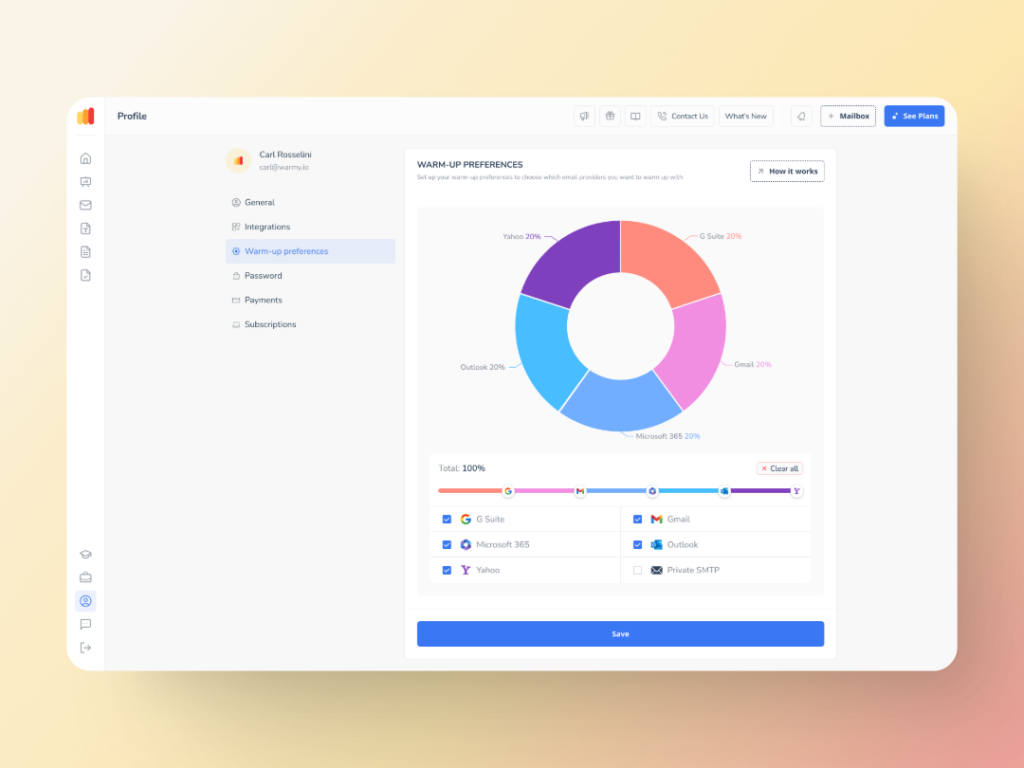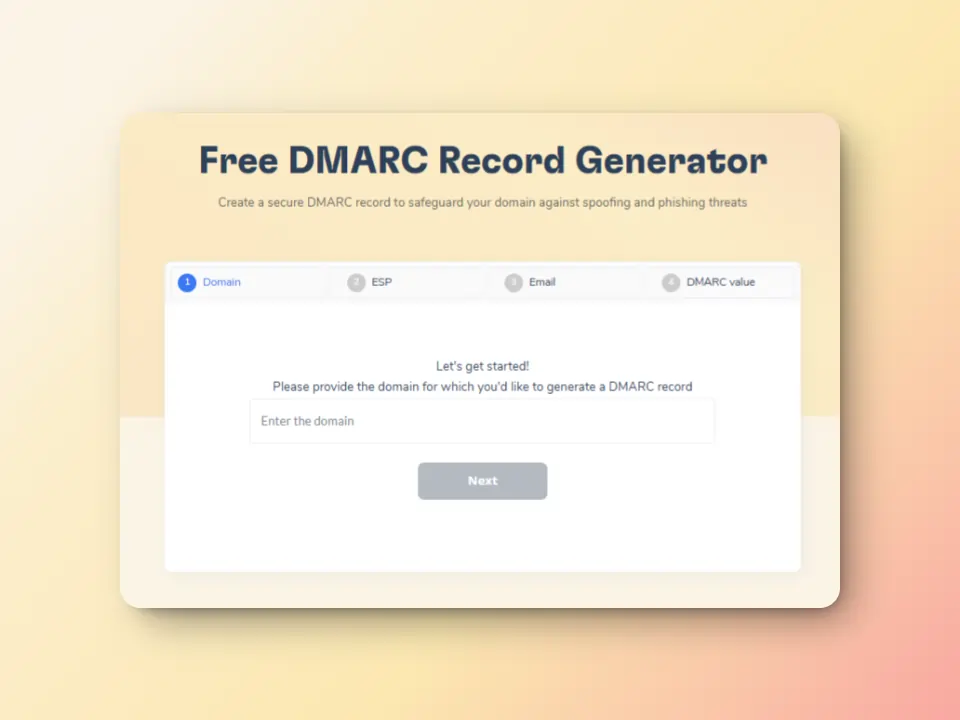Email domain warm up is a necessary process for any business that’s planning to send emails at scale and it’s even more crucial in the cybersecurity space. Cybersecurity companies work in an industry where trust, security, and compliance are everything. It isn’t only about getting to see a $36 return for every $1 worth of spend. Emails must not only land in the inbox, but they must breed trust and reflect the credibility of that organization.
The cybersecurity environment makes domain warmup a bit more challenging than it was before. Filters are getting more sophisticated, people are slightly more wary of the emails they receive. and you have to have a clean sending reputation in order to avoid suspicion of phishing or spoofing.
This article will break down how long it typically takes to warm up an email domain for cybersecurity companies, generally between two to six weeks. We will cover best practices tailored for this sector, discuss common pitfalls, and show how tools like Warmy.io can streamline and secure your warm-up process.
Why email domain warm-up is crucial for cybersecurity firms
Warming up your email domain is not only about the volume that you are sending. It is about building credibility and trust with both the inbox providers and your recipients. For cybersecurity companies, this holds more weight, as every message can be examined for security.
Establishes trust with highly security-conscious recipients
In this sector, more recipients are often more vigilant and suspicious—and with some very legitimate reasons to be. Given that 73% of all reported cyber-incidents in 2024 were business email compromise (BEC) attacks, it makes sense to be extra cautious.
Warm-up works for the cybersecurity industry because consistent sending behavior builds reputation over time. Positive engagement signals (opens, clicks, replies) strengthen inbox provider trust. Thus, proper warm-up avoids triggering suspicion.
Navigates stricter spam and phishing filters
Here’s a fact that isn’t really fun: Google disables around 100 million phishing emails every day. Because of this, email providers are especially cautious when they check the emails’ authenticity, as there is always a chance of a phishing or spoofing attack.
Q: What are phishing and spoofing attacks?
A: Phishing attacks involve emails with fake requests from scammers posing as reputable entities to obtain sensitive data like log-in and password information. Spoofing, in contrast, is a form of phishing where attackers forge the sending address to make it look like the email is coming from someone you trust.
Warm-up helps demonstrate that your emails are legitimate and safe as inbox providers deploy advanced machine learning to detect suspicious activity.
🔖 Related Reading: What is Email Spam and Why Are My Emails Going to Spam? A Comprehensive Guide
Protects brand reputation in a high-risk industry
A poor sender reputation can quickly lead to blacklisting, causing future critical communications to be blocked. Gradual, responsible sending preserves your brand’s credibility since it prevents sudden volume spikes which may be deemed as suspicious by service providers.
Typical warm-up timeline for cybersecurity email domains
Knowing how long a warm-up should take allows security teams to design campaigns appropriately and set realistic expectations. It varies, but here’s a ballpark of what to expect.
Standard duration (2 to 6 weeks)
- New or inactive domains typically require 14-21 days of warm-up. This period allows volume and engagement to ramp up gradually.
- Brand-new or previously inactive domains may need up to 45 days. This timeline allows for more conservative sending schedules to avoid sudden spikes.
Key factors affecting warm-up speed in cybersecurity
Several elements influence how quickly a cybersecurity company’s domain gains reputation and delivers reliably.
Domain age and sending history
Older domains with a positive track record warm up faster. New or dormant domains need slower, more cautious warm-up as they currently have no sending history or reputation to use as basis.
🔖 Related Reading: The Warmy Research Team released a report on the different email platforms and diverse domain configurations and how they affect warm-up. Access the complete report here: The Science and Process of Warming Up Newly Created Email Domains.
Email volume and frequency management
Start small and increase volume steadily. Maintain consistent sending times and frequencies. Sudden spikes can trigger spam filters but consistent sending frequency paired with volume ramp-up helps build trust steadily.
Content quality and engagement signals
Relevant, personalized emails improve open and click-through rates. High engagement signals positively influence provider trust. Poor content quality or irrelevant messages that get marked as spam will slow warm-up progress or harm your reputation.
Technical Setup (SPF, DKIM, DMARC)
Proper configuration SPF, DKIM, and DMARC protocols is mandatory to pass authentication checks. Misconfigurations slow warm-up and reduce deliverability.
Q: What are SPF, DKIM, and DMARC?
A: SPF, DKIM, and DMARC are all email authentication protocols designed to validate if an email is real and not a phony sender. Together, they act to ensure that emails are sent only from sources that are trustworthy—which in turn can boost deliverability and shield users against phishing attacks.
🔖 Related Reading: SPF, DKIM, and DMARC: Boosting Email Security and Deliverability
Impact of previous blacklisting or spam complaints
If the domain or IP address has received a blacklist record in the past, there are additional steps senders must take before diving into the warmup process. The blacklisting history can also add significantly to the warm-up timeline and it’s important to look into this as well.
Best practices for warming up a cybersecurity email domain
The warm-up process can have a big impact on the effectiveness of your first email marketing campaigns. A cold email without proper warming up can actually do you more harm than good.
Start with low volumes to build reputation
Starting with a small volume of emails is crucial when warming up a new domain. Begin with 10-20 emails per day to practice responsible sending. It also reduces the possibility of hitting spam filters on the path. Slow and steady wins the race when it comes warming up emails.
Additional tips:
- Avoid sending large batches at first. This helps ensure that each email is well-received.
- Target engaged recipients. Begin with contacts who have interacted with previous emails or who are already familiar with your domain.
- Track engagement closely. Monitor open rates, clicks, and replies to ensure positive signals.
- Maintain consistency. Send emails at regular intervals to establish predictable sending behavior.
Gradually increase volume based on engagement
After the low-volume phase to get that early sender reputation in place, it is time to begin ramping up the volume. We get it, it’s thrilling—but volume spikes could still signal an issue with ESP’s and could put your reputation at risk, counteracting all of your email success and hygiene efforts so far.
Best practices:
- Increase volume incrementally (20–30% weekly). Gradually ramp up your sending volume over the course of several weeks to avoid sudden spikes.
- Monitor engagement metrics. Track open rates, click-through rates, and feedback to ensure that volume increases correspond with positive user interactions.
- Only increase volume when engagement is consistently high, showing that recipients welcome your emails.
- Avoid sudden spikes. A sharp increase in volume could trigger spam filters. Consistency over intensity is key.
Simulate real responses and interactions
When your emails get good engagement rates, this tells inbox providers that people want and trust your emails. This method is going to help you to establish your domain reputation and remove the concern that your emails will be flagged as spam.
Keep these tips in mind:
- Encourage replies and interaction. Write emails that get responses. Ask engaging questions or post interesting content.
- Use warm-up tools. Leverage tools like Warmy.io that simulate real mailbox interactions, such as replies, opens, and clicks, to create genuine engagement signals.
- Maintain relevance and value. Make sure your emails provide value and that recipients want to interact with you.
- Track engagement data. Monitor the success of simulated interactions to refine your warm-up approach and improve deliverability.
Leverage AI-powered warm-up solutions
There’s no doubt that traditional warm-up works. However, it can quickly become time-consuming, rendering you to no longer have enough time for other business aspects. For example, manually writing emails for each contact and ensuring they are relevant can take hours. Replying to each email manually can also take som much time.
Platforms like Warmy.io optimize warm-up timing and volume by calibrating the sends of your emails with real-time metrics. AI-powered products can automate the process of warming up on platforms, making it faster and less time-consuming.
How email warm-up supports phishing-resistant communication
Email warm-up is paramount for creating a good sender reputation, especially when it comes to companies in risk-heavy sectors such as cybersecurity, fintech, and SaaS. One of the primary benefits of proper email warm-up is that it directly supports phishing-resistant communication by reinforcing email authentication, fostering trust with recipients, and reducing the likelihood of emails being flagged as suspicious.
Reinforces sender authentication
The first step in fighting against phising and spoofing is validating emails appropriately through SPF, DKIM, and DMARC. When properly configured, these protocols specify which senders are allowed to send email from your domain.
Warm-up helps strengthen these protocols by building a consistent and reliable sending history, allowing inbox providers to trust your emails over time. Without this foundation, even legitimate emails may be flagged as phishing attempts, especially in industries where security is critical.
🔖 Related Reading: Mastering Email Deliverability: The Modern Guide to Authentication and Inbox Warm-Up is a comprehensive report from the Warmy Research Team. It aims to give a clear picture on how email warmup and authentication work together.
Builds recipient confidence through consistency
Regular, expected email sends help recipients recognize that your messages are legitimate, especially in industries like cybersecurity, where trust is paramount. Sudden changes in email volume or content, however, can trigger spam or phishing flags, leading to your emails being filtered out before they even reach the inbox.
Reduces false positives in spam filtering
Sometimes, even legitimate emails are incorrectly flagged as spam or phishing attempts. This can happen when a legitimate sender gets too excited and sends out bulk campaigns right away. Or when they aren’t well-versed on certain words or punctuations that set off spam triggers. Email warm-up lowers these chances of misclassification as it focuses on building a consistent positive reputation.
Leveraging Warmy.io for cybersecurity domain warm-up
Warming up an email domain manually can be time-consuming, especially for cybersecurity firms handling sensitive communications where trust and security are non-negotiable. Here’s how Warmy.io helps cybersecurity companies warm up their domains and improve deliverability.
AI-driven warm-up tailored for security companies
Warmy.io’s AI-powered warm-up process analyzes your domain’s history, sending patterns, and mailbox provider preferences to implement a customized warm-up strategy. The platform adjusts the warm-up pace in real-time based on engagement data, ensuring gradual volume increases that protect your sender reputation while maximizing inbox placement. This is particularly crucial for cybersecurity firms, where rapid volume increases can trigger spam filters and harm your credibility.
- Each and every email message sent through Warmy is fully personalized to increase deliverability and prove you’re not a spammer.
- The auto-archive feature takes care of keeping your inbox clean. The warm-up process can happen behind the scenes and you won’t feel any disruptions at all.
- The new Warmup Preferences feature also allows cybersecurity companies to customize how the warm-up is distributed across major providers like Gmail, Outlook, and Yahoo. Senders can also choose between B2B or B2C engagement patterns to tailor the warm-up process according to the unique nature of your cybersecurity audience.

Real mailbox interactions to boost trust signals
Unlike automated bots or fake accounts that purchased lists usually have, Warmy.io’s advanced seed lists use real mailboxes and exchange genuine interactions. These real interactions, such as opens and replies, generate positive engagement signals that help build a solid sender reputation. Here’s how it works:
- Authentic engagement data such as email opens, clicks, scrolls, and replies.
- Emails that land in spam are identified, removed, and flagged as important, so mailbox providers recognize your legitimate intent.

Comprehensive deliverability monitoring
Warmy.io’s deliverability monitoring dashboards offer comprehensive insights into the health of your domain. This includes analyzing inbox placement, bounce rates, and spam complaints in real-time. By tracking key deliverability metrics, you can proactively address issues before they impact your email campaigns.
The Domain Health Hub includes the following features:
- A domain health score based on authentication, blacklist status, and inbox placement tests.
- Weekly or monthly monitoring of your spam rate trends and overall deliverability performance.
- Comprehensive DNS status checks to easily validate SPF, DKIM, DMARC, rDNS, MX, and A records for stronger authentication & security.
- Optimized multi-domain monitoring so users can manage all their domains from one dashboard and identify which ones need immediate attention.
Warmy’s free email deliverability test quickly gives senders an idea of where your emails are landing. You’ll get an idea of the percentage of emails that ends in spam, promotions, inbox, and unreceived across major email providers.
Compliance and security-focused features
Though all industries must adhere to authentication protocols and other security measures, cybersecurity firms must put in double the effort. Cybercriminals have been known to use cybersecurity companies as their cover-up for phishing attempts.
Warmy.io’s platform is designed with these concerns in mind, providing tools and processes tailored to the high standards of the cybersecurity industry:
- The platform ensures that your emails are not only delivered securely but also comply with industry regulations like GDPR and CAN-SPAM.
- Free SPF Record Generator: helps create a valid SPF record to prevent unauthorized email sending.
Free DMARC Record Generator: strengthens email security by preventing phishing and spoofing attacks.

Secure your emails and build a trusted sender reputation with Warmy.io
Warming up your email domain properly is a critical step for cybersecurity companies aiming to achieve high deliverability rates while maintaining a strong sender reputation. By leveraging Warmy.io’s features, you can ensure that your emails reach the inbox and are recognized as legitimate by recipients and inbox providers.
Ready to improve your cybersecurity email deliverability and protect your sender reputation? Time is of the essence! Start your free trial today, or get a personalized demo.











